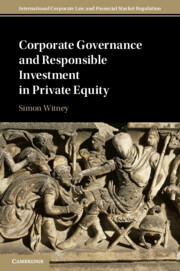Book contents
- Corporate Governance and Responsible Investment in Private Equity
- International Corporate Law and Financial Market Regulation
- Corporate Governance and Responsible Investment in Private Equity
- Copyright page
- Dedication
- Contents
- Acknowledgements
- Introduction
- Part I How Should Private Equity Governance Systems Look?
- Part II What Actually Happens?
- 3 Agency Cost Mitigation
- 4 Improving Decision-Making and Protecting Wider Interests
- Part III Corporate Governance Regulation in the United Kingdom and Private Equity’s Response
- Part IV How Governance Can Affect Corporate Performance
- Bibliography
- Index
4 - Improving Decision-Making and Protecting Wider Interests
from Part II - What Actually Happens?
Published online by Cambridge University Press: 16 November 2020
- Corporate Governance and Responsible Investment in Private Equity
- International Corporate Law and Financial Market Regulation
- Corporate Governance and Responsible Investment in Private Equity
- Copyright page
- Dedication
- Contents
- Acknowledgements
- Introduction
- Part I How Should Private Equity Governance Systems Look?
- Part II What Actually Happens?
- 3 Agency Cost Mitigation
- 4 Improving Decision-Making and Protecting Wider Interests
- Part III Corporate Governance Regulation in the United Kingdom and Private Equity’s Response
- Part IV How Governance Can Affect Corporate Performance
- Bibliography
- Index
Summary
This chapter explains that a central feature of private equity governance mechanisms is a system designed to improve decision-making. Through an explanation of the typical structures seen in practice, it considers the main ways in which better decision-making is facilitated. These structures – most importantly, the board of directors of the company – differ according to the size, type and stage of development of the company, as well as the skills and expertise of the relevant stakeholders. This chapter also looks at the ways in which private equity firms seek to protect their own interests, as distinct from those of the underlying company. That question is examined from a number of perspectives, including the need for a private equity investor to sell the company within a defined time frame, and its need to protect its own reputation with a wide variety of stakeholders. Building on this analysis, and connecting in particular with the various objectives of private equity firms, this chapter considers how, if at all, private equity firms design governance mechanisms with a view to protecting external stakeholders.
Keywords
- Type
- Chapter
- Information
- Publisher: Cambridge University PressPrint publication year: 2021



